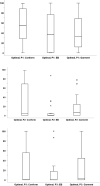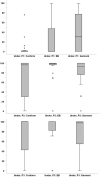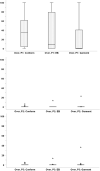Comparative study of optimal compression pressure between conventional Barton's dressing and prefabricate garment in parotidectomy patients
- PMID: 39040018
- PMCID: PMC11263807
- DOI: 10.1111/iwj.70005
Comparative study of optimal compression pressure between conventional Barton's dressing and prefabricate garment in parotidectomy patients
Abstract
Excessive compression after parotidectomy can lead to flap necrosis, while inadequate pressure can cause fluid accumulation. This study aimed to determine the optimal pressure and compression properties of different types of dressings. Initially, pressure measurements were taken for conventional Barton's dressing and a pre-fabricated facial garment. In the subsequent phase, patients were randomly assigned to receive one of three types of pressure dressings: conforming bandage Barton's dressing, elastic bandage Barton's dressing or pre-fabricated facial garment. The dressing types were randomly crossed over the following day. The mean pressure exerted by conventional Barton's dressing and the pre-fabricated facial garment was 15.86 and 14.81 mmHg, respectively. There was no significant difference in the proportion of optimal pressure among the three types of pressure dressing (p-values of 0.195, 0.555 and 0.089 at pre-auricular, angle of mandible and post-auricular sites, respectively). The pre-auricular area demonstrated the highest proportion of optimal pressure, while suboptimal pressure was noted at the angle of the mandible and post-auricular area. Dressing types had no effect on pressure stability (p = 0.37), and there was no significant difference in patient preference (p = 0.91). Conforming bandage Barton's dressing, elastic bandage Barton's dressing and pre-fabricated facial garment exhibit comparable compressive properties, with no significant difference in patient preference and pressure stability.
Keywords: Barton's dressing; hematoma; parotidectomy; seroma; skin flap necrosis.
© 2024 The Author(s). International Wound Journal published by Medicalhelplines.com Inc and John Wiley & Sons Ltd.
Conflict of interest statement
The authors declare no conflicts of interest.
Figures



References
-
- Kontos M, Petrou A, Prassas E, et al. Pressure dressing in breast surgery: is this the solution for seroma formation? J BUON. 2008;13:65‐67. - PubMed
-
- Yoon YH, Park JY, Choi JW, Koo BS. Iatrogenic ear lobule ischemic injury from pressure dressing as an unusual complication of parotidectomy. Am J Otolaryngol. 2008;29:361‐362. - PubMed
-
- Powell BW. The value of head dressings in the postoperative management of the prominent ear. Br J Plast Surg. 1989;42:692‐694. - PubMed
-
- Wax M, Tarshis L. Post‐parotidectomy fistula. J Otolaryngol. 1991;20:10‐13. - PubMed
-
- Corcione F, Califano L. Treatment of parotid gland tumors. Int Surg. 1990;75:171‐173. - PubMed
Publication types
MeSH terms
Grants and funding
LinkOut - more resources
Full Text Sources

